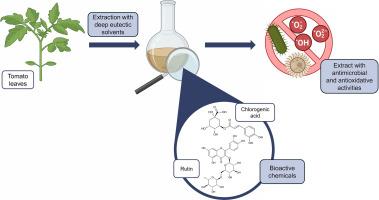利用天然深共晶溶剂对废弃番茄叶进行增值处理
IF 9.8
1区 农林科学
Q1 CHEMISTRY, APPLIED
引用次数: 0
摘要
在种植可食用植物过程中产生的废物可以是生物活性分子的宝贵来源。在此,我们提出了番茄叶的增值,以获得生物活性提取物。采用天然成分组成的深共晶溶剂(DESs)作为提取溶剂。提取物中含有丰富的酚类物质和类黄酮等生物活性物质,以芦丁为主要成分(生物量~6 mg/g)。所得提取物具有较高的抗氧化活性。此外,还可以回收DES用于后续的提取。对所选细菌(大肠杆菌和表皮葡萄球菌)和酵母菌(白色念珠菌)的抑菌活性进行了评价,结果表明其具有较强的抑菌活性,而纯溶剂则没有这种特性。研究表明,坚持循环经济原则,利用天然DESs提取废弃番茄叶,可以高产地获得有价值的抗氧化剂和抗菌剂。本文章由计算机程序翻译,如有差异,请以英文原文为准。


Valorization of waste tomato leaves with natural deep eutectic solvents
Waste produced during cultivation of edible plants can be a valuable source of bioactive molecules. Herein, we present the valorization of tomato leaves to obtain biologically active extracts. Deep eutectic solvents (DESs), composed of natural ingredients, were applied as extracting solvents. The extracts were rich in bioactive chemicals such as phenolics and flavonoids, with rutin as the main component (∼6 mg/g of biomass). The obtained extracts showed high antioxidative potential. Moreover, it was possible to recycle DES for subsequent extractions. Evaluation of the antimicrobial activity of the extracts against selected bacteria (Escherichia coli and Staphylococcus epidermidis) and yeast (Candida albicans) revealed that it showed strong antifungal activity, while the pure solvent did not exhibit such properties. The study revealed that by adhering to the principles of the circular economy and extracting waste tomato leaves using natural DESs, valuable antioxidants and antimicrobial agents can be obtained with high yields.
求助全文
通过发布文献求助,成功后即可免费获取论文全文。
去求助
来源期刊

Food Chemistry
工程技术-食品科技
CiteScore
16.30
自引率
10.20%
发文量
3130
审稿时长
122 days
期刊介绍:
Food Chemistry publishes original research papers dealing with the advancement of the chemistry and biochemistry of foods or the analytical methods/ approach used. All papers should focus on the novelty of the research carried out.
 求助内容:
求助内容: 应助结果提醒方式:
应助结果提醒方式:


